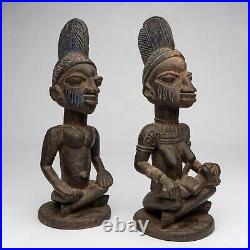
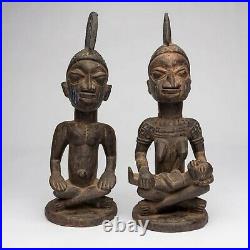
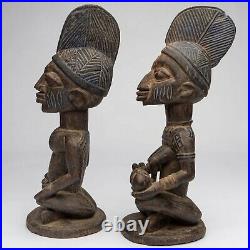
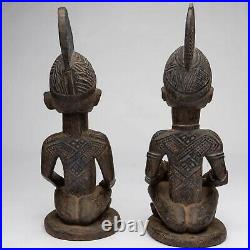
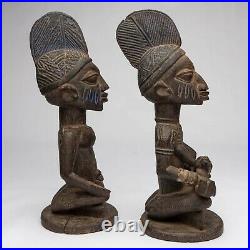
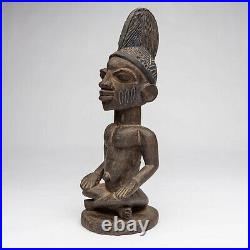
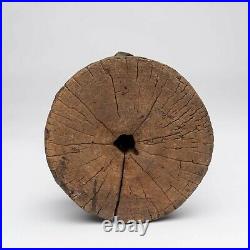
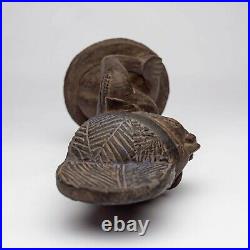
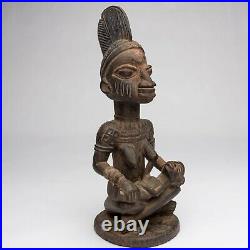
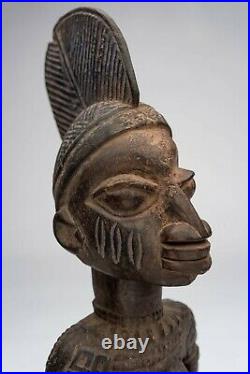
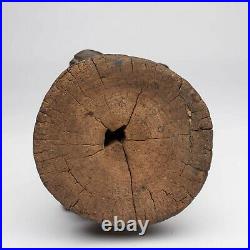
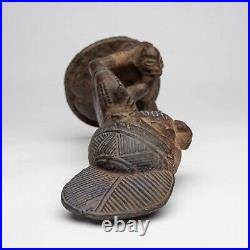

Tous les objets proposés par KG Art Tribal sont des objets qui ont servi lors de cérémonies d’initiation, de danse traditionnelle, de culte etc. Ils ont donc été conçus et utilisés par les ethnies pour leur utilité première. Toutes nos pièces sont donc authentiques. VOUS AIMEZ NOS PRODUITS? SUIVEZ-NOUS EN NOUS AJOUTANT A VOS FAVORIS ICI! La représentation statuaire est bien prescrite dans la culture Yoruba où elle s’imprègne dans la divination. Cette figure symbolise d’abord l’union entre l’homme et la femme qui, ici, sont dans une position de médiation, sinon de prière. Assis sur un fond circulaire, les pieds croisés, l’un sur l’autre à l’instar des bouddhistes, ce couple semble exprimer sa gratitude envers « Yemoja », la divinité de la fécondité en milieu Yoruba. Une fécondité manifeste dans cette ouvre par la présence d’un enfant sur les cuisses du personnage féminin élégamment coiffé d’une haute toque destinée aux dignitaires de la société Yoruba. Coiffure d’ailleurs partagée par le personnage masculin. Toutefois, ce qui reste largement flagrant dans cette pièce, ce sont les traits statuaires typiquement Yoruba : des yeux globuleux en forme d’amande, le nez largement épaté, la bouche charnue et par-dessus tout, les trois chéloïdes profondes des nobles Yoruba sur chacune des deux joues. Enfin, cette figure s’illustre comme un symbole puissant de la maternité chez les Yoruba, un groupe ethnique largement présent en Afrique de l’Ouest, s’étendant depuis le Nigéria jusqu’au Ghana, en passant par le Bénin et le Togo. Est la ville centrale de la mythologie Yoruba. Elle est considérée comme le berceau de l’humanité et le centre du monde. Selon la mythologie d’Ife la ville aurait été fondée par le Dieu mineur Oduduwa qui fut le premier Ooni (titre royal propre à Ife). La mythologie Yoruba aurait pu se constituer pour appuyer la légitimité du nouvel État. Ogun, Dieu du fer et de la guerre, y occupe une place importante. La ville est célèbre pour ses têtes en terre cuite et en bronze. Ancienneté présumée : Entre 1950 et 1960. ZONE DE COLLECTE : ENUGU (NIGERIA). L’objet vous sera livré par Mondial Relay pour les pays recevant ce mode de livraison. LIVRAISON DANS LE MONDE ENTIER!!!! (N’hésitez pas à nous demander les tarifs pour les pays hors Union européenne, Suisse et Royaume-Uni). The statuary representation is well prescribed in the Yoruba culture where it is impregnated in divination. This figure symbolizes first of all the union between the man and the woman who, here, are in a position of mediation, if not of prayer. Sitting on a circular background, feet crossed, one on top of the other like the Buddhists, this couple seems to express their gratitude to » Yemoja « , the divinity of fertility in the Yoruba environment. A fertility manifest in this work by the presence of a child on the thighs of the female character elegantly wearing a high hat intended for the dignitaries of Yoruba society. Hairstyle also shared by the male character. However, what remains largely obvious in this piece are the typical Yoruba statuary features: bulging almond-shaped eyes, the broadly flattened nose, the fleshy mouth and above all, the three deep keloids of the Yoruba nobles on each of the two cheeks. Finally, this figure stands out as a powerful symbol of motherhood among the Yoruba, an ethnic group widely present in West Africa, stretching from Nigeria to Ghana, passing through Benin and Togo. Ife is the central city of Yoruba mythology. It is considered the cradle of humanity and the center of the world. According to the mythology of Ife the city would have been founded by the minor God Oduduwa who was the first Ooni (royal title specific to Ife). Yoruba mythology could have been formed to support the legitimacy of the new state. Ogun, god of iron and war, occupies an important place. The city is famous for its terracotta and bronze heads. Presumed seniority: Between 1950 and 1960. COLLECTION AREA: ENUGU (NIGERIA). (Do not hesitate to ask us for prices for countries outside the European Union, Switzerland and United Kingdom). Venez découvrir notre site internet. Cet item est dans la catégorie « Art, antiquités\Art du XIXe et avant\Arts, objets ethniques ». Le vendeur est « kgarttribal » et est localisé dans ce pays: FR. Cet article peut être expédié au pays suivant: Monde entier.
- Quantité unitaire: 1
- Hauteur: 40cm+39cm
- Unité de mesure: m
- Matière: Bois
- Authenticité: Original
- Origine: Afrique(NIGERIA)
- Longueur: 11cm+11cm
- Largeur: 12cm+12cm
- Type: Figurine, Statue
- Poids: 0.760kg + 0.927kg

